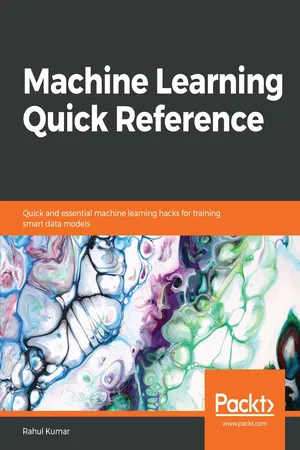
Machine Learning Quick Reference
Quick and essential machine learning hacks for training smart data models
- 294 pages
- English
- ePUB (mobile friendly)
- Available on iOS & Android
Machine Learning Quick Reference
Quick and essential machine learning hacks for training smart data models
About This Book
Your hands-on reference guide to developing, training, and optimizing your machine learning models
Key Features
- Your guide to learning efficient machine learning processes from scratch
- Explore expert techniques and hacks for a variety of machine learning concepts
- Write effective code in R, Python, Scala, and Spark to solve all your machine learning problems
Book Description
Machine learning makes it possible to learn about the unknowns and gain hidden insights into your datasets by mastering many tools and techniques. This book guides you to do just that in a very compact manner.
After giving a quick overview of what machine learning is all about, Machine Learning Quick Reference jumps right into its core algorithms and demonstrates how they can be applied to real-world scenarios. From model evaluation to optimizing their performance, this book will introduce you to the best practices in machine learning. Furthermore, you will also look at the more advanced aspects such as training neural networks and work with different kinds of data, such as text, time-series, and sequential data. Advanced methods and techniques such as causal inference, deep Gaussian processes, and more are also covered.
By the end of this book, you will be able to train fast, accurate machine learning models at your fingertips, which you can easily use as a point of reference.
What you will learn
- Get a quick rundown of model selection, statistical modeling, and cross-validation
- Choose the best machine learning algorithm to solve your problem
- Explore kernel learning, neural networks, and time-series analysis
- Train deep learning models and optimize them for maximum performance
- Briefly cover Bayesian techniques and sentiment analysis in your NLP solution
- Implement probabilistic graphical models and causal inferences
- Measure and optimize the performance of your machine learning models
Who this book is for
If you're a machine learning practitioner, data scientist, machine learning developer, or engineer, this book will serve as a reference point in building machine learning solutions. You will also find this book useful if you're an intermediate machine learning developer or data scientist looking for a quick, handy reference to all the concepts of machine learning. You'll need some exposure to machine learning to get the best out of this book.
Frequently asked questions
Information
Natural Language Processing
- The document term matrix
- Different approaches to looking at text
- Sentiment analysis
- Topic modeling
- The Bayesian technique
Text corpus
Sentences
Words
Bags of words
- Building the corpus: In this step, the documents are collected and combined together to form a corpus. For example, the famous song from the TV series Friends has been used here as a corpus:
When the rain starts to pour
I will be there for you
Like I have been there before
I will be there for you
Table of contents
- Title Page
- Copyright and Credits
- About Packt
- Contributors
- Preface
- Quantifying Learning Algorithms
- Evaluating Kernel Learning
- Performance in Ensemble Learning
- Training Neural Networks
- Time Series Analysis
- Natural Language Processing
- Temporal and Sequential Pattern Discovery
- Probabilistic Graphical Models
- Selected Topics in Deep Learning
- Causal Inference
- Advanced Methods
- Other Books You May Enjoy